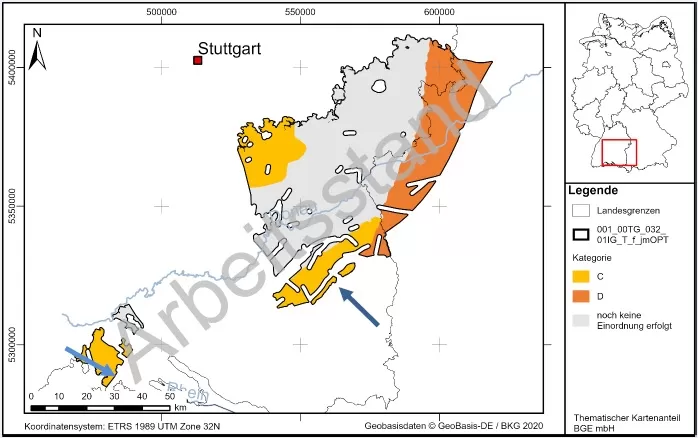
Germany also considering disposal of radioactive waste in Opalinus Clay
Key points at a glance:
– Der Opalinuston bleibt bei der Deutschen Standortsuche weiter im Rennen.
– Germany continues to consider the Opalinus Clay as a potential host rock in its site selection process.
– The BGE does not plan to further investigate a small area immediately north of the Swiss border.
– The reason for this are large underground faults as well as volcanoes that were present in the area.
– “We at Nagra would not want to construct our repository in the Bodensee-Hegau Graben north of the Swiss border, either,” says Nagra’s chief geologist, Tim Vietor.
The site selection process for a deep geological repository is at an early stage in Germany. In a first step, the German federal company for radioactive waste disposal (Bundesgesellschaft für Endlagerung, BGE) identified areas that “are expected to have favourable geological conditions for the safe disposal of high-level radioactive waste”. Around 50 percent of German territory falls into this category – divided into 90 smaller areas. Nine of these are being considered because they have underground clay rock formations.
In the current procedural step, the BGE is narrowing down these extremely large areas and has defined test areas on which the so-called narrowing-down method can be tested. This method will later be applied to reduce the total area of all the sub-areas. One of these test areas includes an area in southern Germany that has a layer of Opalinus Clay. If the BGE were to eventually apply the narrowing-down method currently being tested, a small area immediately adjacent to Switzerland would be excluded from further investigations. However, substantial parts of the test area further north would be subject to a more detailed assessment and therefore remain as potential siting candidates.
Why does the BGE not want to further investigate the area immediately north of the Swiss border?
One reason is that, immediately adjacent to the Swiss border, the so-called Bodensee-Hegau Graben begins. The rock formations in the vicinity of this feature underwent strong movement, creating numerous faults and fractures in the rock. The objective is to avoid such zones for a repository. In addition, until just a few million years ago, southern Germany still had active volcanoes. From deep inside the earth, magma melted its way through all rock formations and emerged at the surface. This process damaged the Opalinus Clay layer in places. The Bodensee-Hegau Graben and the region’s volcanic past led to the classification of this area as “unfavourable” in terms of two assessment criteria.
Furthermore, the BGE describes the thickness of the Opalinus Clay layer of 120 to 130 metres as “less favourable”. The Opalinus Clay layer in Switzerland’s three potential siting regions is approximately 110 to 120 metres thick. In general, the following rule applies: the thicker the clay layer, the better the radioactive waste is enclosed deep underground. However, the Opalinus Clay is not the only important factor. If the rock formations above and below the Opalinus Clay also contain clay, they can be included in the so-called containment-providing rock zone. The Opalinus Clay in Switzerland is surrounded by suitable argillaceous formations, so that the containment-providing rock zone clearly exceeds a thickness of 150 metres in all three siting regions.
In response to the provisional findings from Germany, Tim Vietor, Nagra’s chief geologist, points out: “We at Nagra would not want to construct our deep geological repository in the Bodensee-Hegau Graben north of the Swiss border, either. In the three Swiss siting regions, we can avoid the few existing faults when selecting the repository site. There was no volcanic activity in any of the three siting regions in Switzerland.”
In Switzerland, the search for a deep geological repository site is already further advanced than in Germany. The three regions Jura Ost, Nördlich Lägern and Zürich Nordost are all suitable for constructing the repository. Nagra will be able to announce which region it considers most suitable this autumn. The Federal Council and Parliament have the final say in the search for a site, which is being conducted at the federal level – and, if a referendum is held, the Swiss electorate.